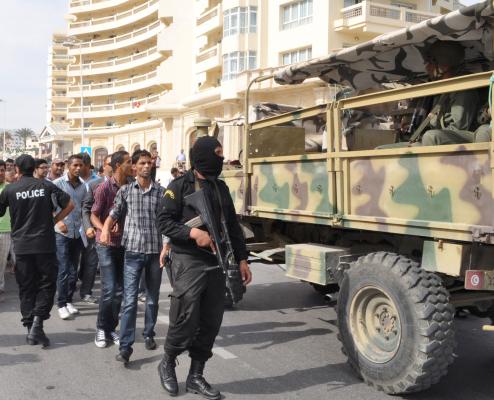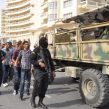
Tunisian Extremists Expand Beyond Their Bases in Jebel Chaambi
Publication: Terrorism Monitor Volume: 12 Issue: 1
By:

2013 marked the return of terrorism to Tunisia. Since the middle of the year, terrorist incidents have occurred with greater frequency and now pose an alarming threat to the safety of Tunisia. During the first half of 2013, the Tunisian security forces were the target of several jihadist attacks, especially in the mountainous area of Jebel Chaambi, on the border with Algeria. This phase, which cannot yet be declared completed, reached its peak with the terrorist attack of July 29, 2013 that resulted in the death of eight soldiers, the worst terrorist attack in recent years in Tunisia. The Tunisian government, with the Ministry of the Interior in the front row, has repeatedly accused the Salafist Ansar al-Shari’a in Tunisia (AST) movement to be responsible for the attacks, but failed to provide evidence.
Indeed, these terrorist actions seemed to have been conducted in a manner that resembled Algerian jihadism. However, on August 27, 2013 the government officially banned the AST, declaring it a terrorist organization. On the one hand, this has contributed to the radicalization of a part of the Salafist group, especially with reference to its base. On the other hand, it has to be emphasized that this reactive policy did not coincide with the end of terrorist activities.
Terrorism spread beyond Jebel Chaambi last October. Two officers of the National Guard were killed on October 17, 2013 in an exchange of fire at Goubellat, in the Beja governorate of northern Tunisia. According to sources within the security apparatus, the assailants belonged to a sleeper cell, composed of individuals who settled in the area as farmers (L’economiste Maghrébin, October 22, 2013). The incident suggested that the militants are no longer just hidden in border areas, but are gradually being placed into internal regions of the country. The reaction of the Tunisian government was massive, including the combined use of air and ground forces. On October 19-20, 2013, the government launched one of its most important offensives since the confrontation with the jihadists that started in December 2012, killed at least 13 suspected terrorists and led to the seizure of two tons of explosive material at Goubellat, near Jebel Touayer (Tunisia Daily, October 19, 2013). The Goubellat operations, conducted jointly by special anti-terrorism squads, the army and the National Guard, have partly succeeded in preventing further attacks from the cell.
However, only a few days later, on October 23, 2013, another attack hit the National Guard in one of the poorest areas of the country, Sidi Ali Ben Aoun, in the governorate of Sidi Bouzid. On that occasion six members of the National Guard and a policeman were killed in an exchange of fire. Two terrorists were killed (Tunis Afrique Press, October 23, 2013). The same day, in Menzel Bourguiba (governorate of Bizerte), a policeman was killed and another wounded by four terrorists shooting from a car, while four other suspected terrorists were arrested (Tunis Afrique Press, October 24, 2013). The state’s response to this expansion of terrorism beyond the Jebel Chaambi area – where it seemed to be confined – has been twofold. To the military reaction on the ground and the campaign of arrests, new legal responses have been added. Immediately after the terrorist attack in Sidi Ali Ben Aoun, an October 24, 2013 meeting of the Higher Council for Security, directed by President Moncef Marzouk, approved legislative measures aimed at making the fight against terrorism more effective and coincided with the establishment of joint anti-terrorist units formed by the army, the national guard and the police forces (Menara [Casablanca], October 24, 2013; Tunivisions, October, 24, 2013).
A suicide bomber blew himself up outside a hotel in the resort city of Sousse on October 30, 2013. On the same day, a man was arrested after attempting to bomb the mausoleum of Tunisia’s first president, Habib Bourguiba in Monastir, Tunisia. Both attacks were unsuccessful; the first only caused the death of the terrorist, while the second was foiled in advance by the security forces. Nevertheless, the two episodes created extreme concern in Tunis and highlighted some trends threatening Tunisian national security:
- The most worrying fact concerns the target of these terrorist acts: having been a peripheral threat directed essentially against the security forces, terrorism in Tunisia now appears likely to target urban centers
- The targets of the October 30, 2013 plots were not only symbolic (as in the case of the mausoleum of Bourguiba), but also strategic and economic. Sousse is one of the most important tourist centers in Tunisia. An attack on the tourism sector could seriously weaken the national economy
- The fact that the suicide bombing and foiled attack occurred on the same day in two different locations; the attacks may have been coordinated
- Finally, the jihadi network that is penetrating the country is fueled by other criminal activities, such as trafficking in drugs, arms and other contraband.
On November 11, 2013, the city of Kebili was the scene of clashes between security forces and a group of suspected terrorists. The shooting resulted in the killing of two militants, while a National Guard officer was wounded (Direct Info, November 12, 2013). However, in late November 2013 the Tunisian authorities announced the dismantling of three terrorist cells in Zarzis, Djerba and Ben Guerdane. In these operations, 20 people were arrested, including four Libyan nationals. Moreover, Tunisian soldiers seized weapons and military uniforms intended to be used for ambushes of the security forces (al-Sabah [Tunis], November 23, 2013). However, jihadist elements still seem to maintain their presence in the Jebel Chaambi area, as an army captain was killed by the explosion of a landmine on December 2, 2013 (Tunisia Live, December 2, 2013).
At the same time, the Tunisian government has continued to reinforce a framework for cooperation both with neighbors (Libya and Algeria) and with other countries such as France. Tunisia is negotiating the purchase of six Caracal transport helicopters, produced by the group Eurocopter, for an estimated $415 million (Maghreb Emergent, November 15, 2013). Although the government has decided to increase the 2014 defense budget by $185 million over last year, the contract has not yet been signed as negotiations on the cost of the helicopters are not complete (Jeune Afrique, December 9, 2013). Indeed, the Tunisian army faces a serious lack of adequate resources to conduct asymmetric warfare-style operations. Therefore, Tunisia is considering a five-year plan aimed at developing and modernizing its army. The United States may support the Tunisian efforts through its Africa Command (AFRICOM). AFRICOM commander David M. Rodriguez has been in Tunis more than once and has reiterated Washington’s commitment to Tunis (Tunis Afrique Presse, November 20, 2013).
The political stalemate represents a further destabilizing factor for Tunisia. Moreover, the government’s repressive policy vis-à-vis the Salafist Ansar al-Shari’a has not helped to defuse tensions. As long as the situation remains insecure, new terrorist attacks could take place. In this context, the Tunisian government is trying to modernize its security apparatus, helped by its external allies, as the jihadist threat enters the country from the Sahel region and from neighboring Algeria and Libya, where Ansar al-Shari’a leader Abu Iyad is reportedly hiding (Tunisia Live, December 30, 2013).
Stefano Maria Torelli is a Research Fellow at the Institute for International Political Studies (ISPI) and a member of the Italian Centre for the Study of Political Islam (CISIP). His research topics include Middle Eastern studies, Political Islam and International Relations.





